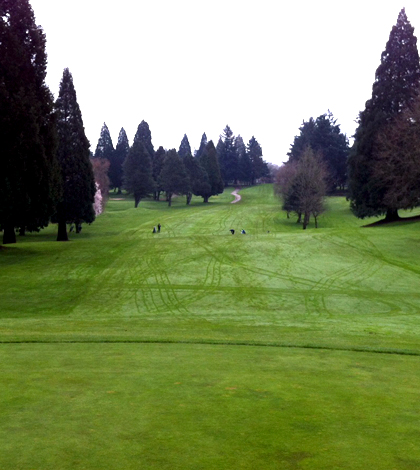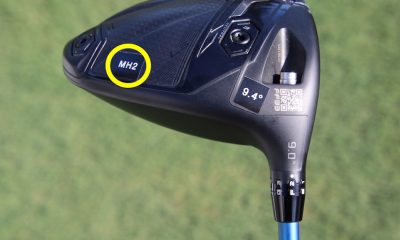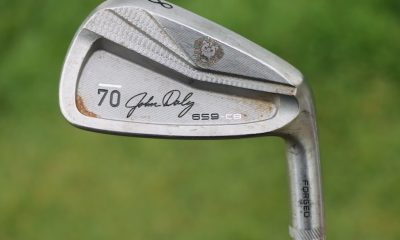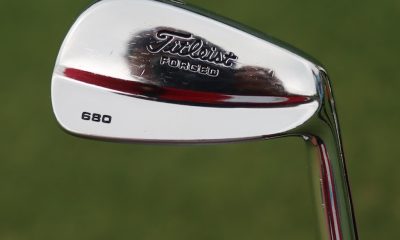Opinion & Analysis
The Dan Plan: First 2013 Tournament

This past weekend, I participated in the first tournament of the Portland, Ore. season. It’s called the Iceberg Open and is a two-day event that typically is held in heavy downpours and generally inclement weather. This year there was a pleasant break in the Portland winter and the Open was held on almost golf-like weathered days.
It was the sixth tournament I have ever entered and a good way to kick off the season. Last year my first tourney was in mid-April at Pumpkin Ridge Golf Course and was a nerve-wracking experience where a film crew from ABC “Nightline,” a local CBS affiliate, my own camera crew and an Associated Press writer all followed intently interested in how I would perform on the first big day out. At the time, I had only played golf with a full set of clubs for 3.5 months and was as nervous as humanly possible while playing the game. It’s not exactly the same scale, but I knew what Rory must have felt like on his final round at the 2011 Masters. Okay, that’s stretching it a bit, but it was pressure unlike I had ever felt before in the game.
This go around I was (not going to lie) nervous to tee it up, but far calmer than 11 months prior. I had put in about 1,000 more practice hours since teeing it at Pumpkin Ridge and knew that I was a way more capable golfer. The first tee shot, though, was a blast of uncertainty.
The back story: I had been struggling with my driver for the past few months, maybe ever since first swinging a driver on Nov. 12, 2011, and had been trying out different types to see what best fit my swing. Nike had provided my original gear and had fit me for one of its VRS drivers, but it never felt right to me. Despite not having ever swung anything other than a couple Nike drivers, I just knew deep down that something wasn’t right. To experiment, I picked up a TaylorMade RBZ driver with a Rul 60-gram shaft and for a while it felt great. But, four months and countless workout sessions later, both on the range and in the gym, the tip of that shaft was feeling like a bull whip and it was time to move on in my driver quest to something a bit stiffer.
Last month I went down to Titleist to get a wedge fitting at Oceanside (see my blog for a full debriefing on that experience) and while there I got to play a round with the new Titleist 913 with a Graphite Design Tour AD-6x shaft in it. I had literally never swung anything that felt so good and immediately I trusted it to produce the results that I thought it should. Granted, the X was a bit too stiff for me, as I swing the driver at about 105 mph, but the overall feel was incredible. I returned to Portland and knew that I needed to find my driver. I tried everything, but couldn’t find that feel that I had with the 913. My home course, Columbia Edgewater Country Club, was scheduled to get the 913 lefties in soon so I was waiting for its arrival to try what I thought would be the driver for me. I had almost four weeks until the Iceberg Open and assumed that it would come in time to try out for the tourney. But, the demo lefty never showed up and a few days before the tourney I was still without a driver that I trusted or enjoyed hitting.
Thursday before the tourney, I pulled out a demo TaylorMade R1 with an Oban Devotion shaft. The demo day fitters set it up to be 2-degrees open and toe heavy to help the face shut, which seemed a little odd to me, but they were the fitters to I trusted them to do their job. That day it hit all right and I figured it was good enough to stick in the bag, but the next day I couldn’t hit it to save my life.
My tee shots both on the course and on the range were all over the place and I was mystified as to why. I decided to sleep on it and had dreams throughout the night about missing drives into water and forests. Not the way you want to wake up the morning of the first tournament. My tee time was 10:45 a.m., so I went to the range in the morning to warm up before heading to Rose City. I worked through all my clubs and felt good then pulled out the big stick. Again I could not hit it. Nothing seemed to work and at this point it didn’t matter if it was the driver or the swing as I had zero confidence in either one. Not knowing what to do I switched the heads and stuck an RBZ on the Devotion shaft. Still nothing. With 30 minutes until my tee time and a 20-minute drive to the club, I had to make a decision: Leave the driver out of the bag or run home and grab my old Nike.
I never particularly liked the Nike, but I did know its profile and knew my misses with it. Having that knowledge I felt that it was the smarter move to grab it for the longer holes. Another slight issue was that I didn’t have a 3-wood and my longest club in the bag besides driver was a 3-hybrid. That’s an entirely different story, though, and one that remedied itself the day after the event. With just a few minutes to spare, I grabbed the Nike and headed to the Iceberg, making it there in time to roll a few putts then kick of tournament golfing season here in Portland.
What would be surprising at this point is if I hit the ball halfway decent with the driver. I’d totally destroyed any confidence I may have ever had with it and basically committed one of the seven deadly sins by switching up so many things literally the hour before my tee time. To recap the front nine: On No. 1, pulled the driver right. On No. 2 hooked it hard right. On No. 4, sliced it short left. On No. 6, blocked it far left. On No. 7, pull hooked it right. On No. 9, pulled it into the trees right. By the time I made the turn I had successfully missed every drive by a significant amount of space and was getting worn down from punching the ball out so many times.
On the back, I put the big stick away for good and decided to tee it with the 3-hybrid. I birdied No. 10 and was off to a much better start. All in all, I shot 6-over on the front and 3-over on the back, all of those back 9 strokes caused by non-tee shot related swings.
The good news is that an 81 tied the best I had ever shot in a tournament round and last year when I carded that score on one of the eight tourney rounds that I played in, it was by the skin of my yellow country teeth. This go around I kind of shot myself in the foot before the first swing, but still pulled off a tied personal record tourney round.
For both rounds I relied on my new Vokey wedges and SeeMore putter to score. I missed more than my share of fairways and greens, but scrambled well and knowing that is possible is a huge boost of confidence for the overall game. I had 25 putts the first day and 26 the second. A lot of that is because I only hit about 10 greens in regulation during 36 holes, but sometime you just don’t hit the ball well and you still have to find a way to get it in the hole. I shot an 81 on the second day when the course was set up much harder and was happy to have tied my record tourney round twice in a row. It was good enough for seventh place net, which managed to pay $225.
What did I learn from this experience? It doesn’t matter what you put in your bag, it matters how much you trust what’s in the bag. It is crucial to have the right gear, and there is nothing more right than a club that you love. I love my wedges and my putter and whenever they are in my hands I feel like I’m going to make the shot. With the driver there is no feel right now. When I get it out of the bag I can’t help but think “Where are you going to go this time?” The game is hard enough on it’s own, why make it harder with doubt?
I have decided that in order for me to develop the most trust in my clubs I need to return to Oceanside, Calif., for a full club fitting at Titleist. I was blown away by the wedge fitting that I had there last month and can’t imagine entrusting the rest of my sticks to anyone but the best. I booked a date to head back there for a full fitting on April 25. Until then, I will continue to play around with different drivers as well as work on my timing as I know that is a crucial part when the ball starts heading both left and right.
It has taken me about a year to realize how important gear is in this wonderful game. The biggest realization I have had during that time is that building a trusting relationship with each stick is crucial to being the best golfer you can be. I’m glad for this experience and despite the fact that I coulda/woulda/shoulda, I learned a ton from last weekend and am going to be a better golfer from that experience.
Opinion & Analysis
The 2 primary challenges golf equipment companies face

As the editor-in-chief of this website and an observer of the GolfWRX forums and other online golf equipment discourse for over a decade, I’m pretty well attuned to the grunts and grumbles of a significant portion of the golf equipment purchasing spectrum. And before you accuse me of lording above all in some digital ivory tower, I’d like to offer that I worked at golf courses (public and private) for years prior to picking up my pen, so I’m well-versed in the non-degenerate golf equipment consumers out there. I touched (green)grass (retail)!
Complaints about the ills of and related to the OEMs usually follow some version of: Product cycles are too short for real innovation, tour equipment isn’t the same as retail (which is largely not true, by the way), too much is invested in marketing and not enough in R&D, top staffer X hasn’t even put the new driver in play, so it’s obviously not superior to the previous generation, prices are too high, and on and on.
Without digging into the merits of any of these claims, which I believe are mostly red herrings, I’d like to bring into view of our rangefinder what I believe to be the two primary difficulties golf equipment companies face.
One: As Terry Koehler, back when he was the CEO of Ben Hogan, told me at the time of the Ft Worth irons launch, if you can’t regularly hit the golf ball in a coin-sized area in the middle of the face, there’s not a ton that iron technology can do for you. Now, this is less true now with respect to irons than when he said it, and is less and less true by degrees as the clubs get larger (utilities, fairways, hybrids, drivers), but there remains a great deal of golf equipment truth in that statement. Think about it — which is to say, in TL;DR fashion, get lessons from a qualified instructor who will teach you about the fundamentals of repeatable impact and how the golf swing works, not just offer band-aid fixes. If you can’t repeatably deliver the golf club to the golf ball in something resembling the manner it was designed for, how can you expect to be getting the most out of the club — put another way, the maximum value from your investment?
Similarly, game improvement equipment can only improve your game if you game it. In other words, get fit for the clubs you ought to be playing rather than filling the bag with the ones you wish you could hit or used to be able to hit. Of course, don’t do this if you don’t care about performance and just want to hit a forged blade while playing off an 18 handicap. That’s absolutely fine. There were plenty of members in clubs back in the day playing Hogan Apex or Mizuno MP-32 irons who had no business doing so from a ballstriking standpoint, but they enjoyed their look, feel, and complementary qualities to their Gatsby hats and cashmere sweaters. Do what brings you a measure of joy in this maddening game.
Now, the second issue. This is not a plea for non-conforming equipment; rather, it is a statement of fact. USGA/R&A limits on every facet of golf equipment are detrimental to golf equipment manufacturers. Sure, you know this, but do you think about it as it applies to almost every element of equipment? A 500cc driver would be inherently more forgiving than a 460cc, as one with a COR measurement in excess of 0.83. 50-inch shafts. Box grooves. And on and on.
Would fewer regulations be objectively bad for the game? Would this erode its soul? Fortunately, that’s beside the point of this exercise, which is merely to point out the facts. The fact, in this case, is that equipment restrictions and regulations are the slaughterbench of an abundance of innovation in the golf equipment space. Is this for the best? Well, now I’ve asked the question twice and might as well give a partial response, I guess my answer to that would be, “It depends on what type of golf you’re playing and who you’re playing it with.”
For my part, I don’t mind embarrassing myself with vintage blades and persimmons chasing after the quasi-spiritual elevation of a well-struck shot, but that’s just me. Plenty of folks don’t give a damn if their grooves are conforming. Plenty of folks think the folks in Liberty Corner ought to add a prison to the museum for such offences. And those are just a few of the considerations for the amateur game — which doesn’t get inside the gallery ropes of the pro game…
Different strokes in the game of golf, in my humble opinion.
Anyway, I believe equipment company engineers are genuinely trying to build better equipment year over year. The marketing departments are trying to find ways to make this equipment appeal to the broadest segment of the golf market possible. All of this against (1) the backdrop of — at least for now — firm product cycles. And golfers who, with their ~15 average handicap (men), for the most part, are not striping the golf ball like Tiger in his prime and seem to have less and less time year over year to practice and improve. (2) Regulations that massively restrict what they’re able to do…
That’s the landscape as I see it and the real headwinds for golf equipment companies. No doubt, there’s more I haven’t considered, but I think the previous is a better — and better faith — point of departure when formulating any serious commentary on the golf equipment world than some of the more cynical and conspiratorial takes I hear.
Agree? Disagree? Think I’m worthy of an Adam Hadwin-esque security guard tackle? Let me know in the comments.
@golfoncbs The infamous Adam Hadwin tackle ? #golf #fyp #canada #pgatour #adamhadwin ? Ghibli-style nostalgic waltz – MaSssuguMusic
Podcasts
Fore Love of Golf: Introducing a new club concept

Episode #16 brings us Cliff McKinney. Cliff is the founder of Old Charlie Golf Club, a new club, and concept, to be built in the Florida panhandle. The model is quite interesting and aims to make great, private golf more affordable. We hope you enjoy the show!
Opinion & Analysis
On Scottie Scheffler wondering ‘What’s the point of winning?’

Last week, I came across a reel from BBC Sport on Instagram featuring Scottie Scheffler speaking to the media ahead of The Open at Royal Portrush. In it, he shared that he often wonders what the point is of wanting to win tournaments so badly — especially when he knows, deep down, that it doesn’t lead to a truly fulfilling life.
View this post on Instagram
“Is it great to be able to win tournaments and to accomplish the things I have in the game of golf? Yeah, it brings tears to my eyes just to think about it because I’ve literally worked my entire life to be good at this sport,” Scheffler said. “To have that kind of sense of accomplishment, I think, is a pretty cool feeling. To get to live out your dreams is very special, but at the end of the day, I’m not out here to inspire the next generation of golfers. I’m not out here to inspire someone to be the best player in the world, because what’s the point?”
Ironically — or perhaps perfectly — he went on to win the claret jug.
That question — what’s the point of winning? — cuts straight to the heart of the human journey.
As someone who’s spent over two decades in the trenches of professional golf, and in deep study of the mental, emotional, and spiritual dimensions of the game, I see Scottie’s inner conflict as a sign of soul evolution in motion.
I came to golf late. I wasn’t a junior standout or college All-American. At 27, I left a steady corporate job to see if I could be on the PGA Tour starting as a 14-handicap, average-length hitter. Over the years, my journey has been defined less by trophies and more by the relentless effort to navigate the deeply inequitable and gated system of professional golf — an effort that ultimately turned inward and helped me evolve as both a golfer and a person.
One perspective that helped me make sense of this inner dissonance around competition and our culture’s tendency to overvalue winning is the idea of soul evolution.
The University of Virginia’s Division of Perceptual Studies has done extensive research on reincarnation, and Netflix’s Surviving Death (Episode 6) explores the topic, too. Whether you take it literally or metaphorically, the idea that we’re on a long arc of growth — from beginner to sage elder — offers a profound perspective.
If you accept the premise literally, then terms like “young soul” and “old soul” start to hold meaning. However, even if we set the word “soul” aside, it’s easy to see that different levels of life experience produce different worldviews.
Newer souls — or people in earlier stages of their development — may be curious and kind but still lack discernment or depth. There is a naivety, and they don’t yet question as deeply, tending to see things in black and white, partly because certainty feels safer than confronting the unknown.
As we gain more experience, we begin to experiment. We test limits. We chase extreme external goals — sometimes at the expense of health, relationships, or inner peace — still operating from hunger, ambition, and the fragility of the ego.
It’s a necessary stage, but often a turbulent and unfulfilling one.
David Duval fell off the map after reaching World No. 1. Bubba Watson had his own “Is this it?” moment with his caddie, Ted Scott, after winning the Masters.
In Aaron Rodgers: Enigma, reflecting on his 2011 Super Bowl win, Rodgers said:
“Now I’ve accomplished the only thing that I really, really wanted to do in my life. Now what? I was like, ‘Did I aim at the wrong thing? Did I spend too much time thinking about stuff that ultimately doesn’t give you true happiness?’”
Jim Carrey once said, “I think everybody should get rich and famous and do everything they ever dreamed of so they can see that it’s not the answer.”
Eventually, though, something shifts.
We begin to see in shades of gray. Winning, dominating, accumulating—these pursuits lose their shine. The rewards feel more fleeting. Living in a constant state of fight-or-flight makes us feel alive, yes, but not happy and joyful.
Compassion begins to replace ambition. Love, presence, and gratitude become more fulfilling than status, profits, or trophies. We crave balance over burnout. Collaboration over competition. Meaning over metrics.
Interestingly, if we zoom out, we can apply this same model to nations and cultures. Countries, like people, have a collective “soul stage” made up of the individuals within them.
Take the United States, for example. I’d place it as a mid-level soul: highly competitive and deeply driven, but still learning emotional maturity. Still uncomfortable with nuance. Still believing that more is always better. Despite its global wins, the U.S. currently ranks just 23rd in happiness (as of 2025). You might liken it to a gifted teenager—bold, eager, and ambitious, but angsty and still figuring out how to live well and in balance. As much as a parent wants to protect their child, sometimes the child has to make their own mistakes to truly grow.
So when Scottie Scheffler wonders what the point of winning is, I don’t see someone losing strength.
I see someone evolving.
He’s beginning to look beyond the leaderboard. Beyond metrics of success that carry a lower vibration. And yet, in a poetic twist, Scheffler did go on to win The Open. But that only reinforces the point: even at the pinnacle, the question remains. And if more of us in the golf and sports world — and in U.S. culture at large — started asking similar questions, we might discover that the more meaningful trophy isn’t about accumulating or beating others at all costs.
It’s about awakening and evolving to something more than winning could ever promise.
























Ben
Aug 2, 2014 at 5:23 am
Top work Dan. I noticed you are now accepting donations? Have you considered lessons/ motivational speaking ect to supplement your quest? I have massive respect for your resolve, resilience and perseverance. You will play in a pga tour event- possibly at a Brown Deer Park, Milwaukee, where you will realise your dream and make the cut. Stay focused.
Martin
Apr 29, 2013 at 8:54 am
You weight the heel for a draw bias not the toe. So if they put weight in the toe they created a fade bias.
But you probably suspected that!
Pingback: On The Radio Tomorrow and Other News
Kadin Mahmet
Apr 20, 2013 at 10:10 am
I’m definitely excited to see the end result! Keep up the good work!!
Jack
Apr 19, 2013 at 9:45 pm
Nice progress! Sometimes I feel like it’s not just hours, but also the time to digest. The driver will come along soon enough and you’ll have the short game to pair with it for low scores!